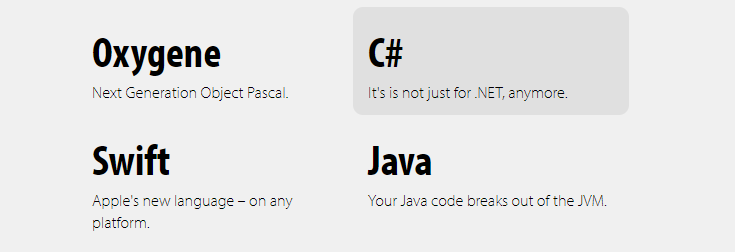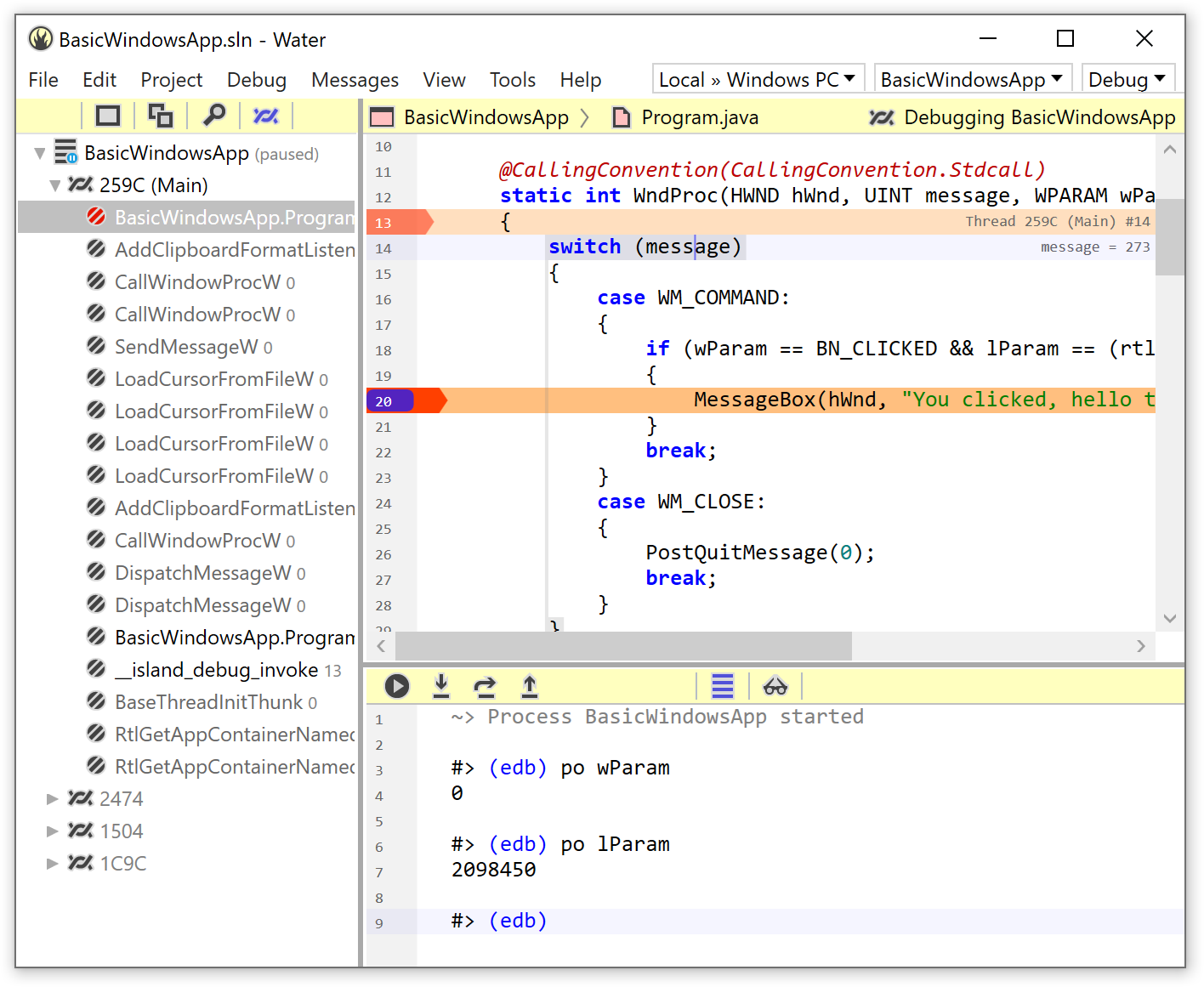Table of Contents
1. Introduction to Elements
2. Elements Versions
3. What Can Elements Do
4. Elements IDEs
5. Elements Tools

1. Introduction to Elements
RemObjects Elements is a multi-platform mobile project development tool that helps developers create mobile projects on different platforms.
Developer: Remobjects Software
-
Elements is available on two operating systems: Windows, Mac
-
Four versions: Visual Studio 2017 Integrated, Professional, Enterprise, and Free Community Edition
-
Supports four programming languages: Oxygene, Java, C#, Swift (Versions before 10.0 only supported Java, C#, and Swift)

-
Elements uses C# from RemObjects C#, which is powerful enough to modify a language and improve its features~~ impressive~
-
Elements has its own development environments Fire, Water (can also be understood as integrated development tools)
-
Oxygene is an object-oriented programming language based on Object Pascal, with a rich feature set. It is a port of Pascal and belongs to the .NET CLR series of languages~~~
-
The integrated version can be used with VS 2017, named Elements in Visual Studio
Summary:
Elements is a multi-platform mobile project development tool that allows development using various programming languages like Oxygene, C#, Swift, and Java, providing a rich, modern development environment. It expands developers' capabilities based on existing programming experience, greatly facilitating software project development.
2. Elements Versions
Elements offers three versions aimed at developers and enterprises based on usage fees.
|
Version Name |
Description |
Price |
|
Silver Community Edition |
Use the Swift language to create apps. In summary, it allows you to create applications using Swift, and work on Mac and Win (integrated with Visual Studio). |
Free |
|
Elements Developer License |
Use Oxygene, C#, Swift or Java to create apps. Use Oxygene, C#, Swift, or Java to create applications. Get technical support and weekly updates. License is provided per user, meaning a single-user license. |
$799 |
|
Elements Company License |
Use Oxygene, C#, Swift or Java to create your apps. Use Oxygene, C#, Swift, or Java to create applications. Get priority support and access to daily builds. The license covers all developers in your team, essentially a company-wide license. |
$7999 |
Of course, students and teachers have it easier~ There is an academic version.
|
Elements Academic License |
Use Oxygene, C#, Swift, or Java to create apps. |
$199 |
|
Elements Class License |
Use Oxygene, C#, Swift or Java to create your apps. |
$999 |
3. What Can Elements Do
Elements can create applications for Android, iOS, Mac under Win/Mac systems, and importantly, you can use C#, Swift, Java or any of these languages for development. Amazing, right? (Of course, this doesn't mean using different code for the same project...)
Similar products on .NET include Microsoft-acquired Xamarin, which helps you create mobile apps using C# and Xamarin, yet even .NET developers rarely use Xamarin. In reality, there are many solutions for cross-platform, cross-language mobile application development, and Xamarin does not have a significant advantage.
The following are the types of applications that Elements can develop:

4. Elements IDEs
Here is the internal structure diagram of Elements; the left box represents the environment and compiler, equivalent to .NET. The right box represents the IDE editor, i.e., the development tools.

Elements offers strong development environment support and multiple IDE tools, and its IDE is also impressive, with 4 versions of IDE.
1. Fire
Used for development on Mac, supporting four languages and all platform developments, including .NET, Java, Android, Windows and Linux applications.
Features:
-
Advanced editing functionality
-
Unit testing integration
-
Cross-platform debugging and deployment

2. Water
Used for application development in Windows, I won't go into further detail~~~

3. Elements in VS
Elements is comprehensively integrated with Visual Studio, extending to almost all aspects of the IDE, with the following features:
-
Universal project templates for all elements languages and platforms
-
Intelligent code editor with smart insights and advanced productivity features
-
Rich debugging capabilities for all platforms, including cross-network debugging for Mac, Linux and iOS
-
Seamless interaction with Elements.NET projects, Microsoft Visual C# and Visual Basic projects
-
Full support for visual designers, including WinForms, WPF, ASP.NET, etc.
-
EBuild is deeply integrated with the Visual Studio build infrastructure
We can see it in Elements in VS (Elements with Visual Studio):

4. Command Line
Whether on Mac, Windows or Linux, you can build projects using the IDE editor and EBuild command line. Just use the standalone EBuild command from the terminal or automatically generated scripts. EBuild is the underlying framework, while Fire, Water, Vs are the IDE tools. You can write applications using the command line or notepad (if you are good enough~), and you can also integrate EBuild into third-party IDE.
According to official information, EBuild will be open-sourced on Github, but I just looked on Github and found no trace of it.
5. Elements Tools
Elements provides powerful tools that let you soar in development.
-
CrossBox
-
FXGen
-
Profiler
-
Obfuscation
-
Oxidizer
-
Marzipan
CrossBox
CrossBox is a cross-platform system debugging project and build project solution. With CrossBox, you can debug applications on Mac, Linux from Windows, and vice versa. CrossBox does not include the operating system and requires a remote connection to the host you intend to debug. This means you provide a physical device, and CrossBox allows you to debug applications running on the remote host, feeding test and debugging data back to the development host.
Mac hosts using CrossBox support the following platforms and operating systems:
| Platform | SubPlatform | Build | Debug | Comments |
|---|---|---|---|---|
| .NET | local | local |
.NET projects build and run locally on Windows Translation: Build and run .NET projects on Windows; I won’t translate further. |
|
| Java | Plain | local | local | Java projects build and run locally on Windows |
| Java | Android | local | locally attached device | Java projects build and run locally on Windows |
| Cocoa | macOS | CrossBox 2 | CrossBox 2 | Need a Mac to build and will debug remotely |
| Cocoa | iOS | CrossBox 2 | CrossBox 2 | Need a Mac to build and will debug remotely |
| Cocoa | tvOS | CrossBox 2 | CrossBox 2 | Need a Mac to build and will debug remotely |
| Island | Windows | local | local | Build and run locally |
| Island | Linux | local | local, CrossBox 2 | Build locally, debug locally or remotely |
| Island | Darwin | local | CrossBox 2 | Build locally, debug remotely |
Win hosts using CrossBox support the following platforms and operating systems:
| Platform | SubPlatform | Build | Debug | Comments |
|---|---|---|---|---|
| .NET | local | local | .NET projects build and run locally on Mac | |
| Java | Plain | local | local | Java projects build and run locally on Mac |
| Java | Android | local | locally attached device | Java projects build locally on Mac |
| Cocoa | macOS | local | local | Cocoa apps build and run locally on Mac |
| Cocoa | iOS | local | locally attached iOS device | Cocoa apps build locally on Mac |
| Cocoa | tvOS | local | locally attached Apple TV | Cocoa apps build locally on Mac |
| Island | Windows | local | CrossBox 2 | Build locally, debug remotely |
| Island | Linux | local | CrossBox 2 | Build locally, debug remotely |
| Island | Darwin | local | local, CrossBox 2 | Build locally, debug locally or remotely |
FXGen
GUI frontend command line tool, related to macOS, iOS, tvOS and watchOS, now supports Objective-C. The author’s English is poor, the official introduction seems to incorporate Xcode (the development tool for developing Apple products on Mac) project files into the Elements IDE, associating .fx and .h files.
Profiler
A cross-platform performance analyzer that monitors code execution and application performance on remote hosts, analyzing performance data.
Obfuscation
Tools to protect code and prevent decompilation. According to the official explanation, it utilizes code obfuscation techniques.
The author's English is truly poor...

Oxidizer
Supports code reuse from programming languages such as C#, Java, Objective-C, Delphi, Oxygene, Swift within a project, allowing the usage of code from other languages and converting it.
In other words, if your C# project needs to use an algorithm found in Java on Baidu, then Oxidizer can help you perfectly and seamlessly convert it to C#~
Languages supported for conversion:
| Source Language | Convert To |
|---|---|
| C# | Oxygene |
| C# | Swift |
| Java | Oxygene |
| Java | C# |
| Java | Swift |
| Objective-C | Oxygene |
| Objective-C | C# |
| Objective-C | Swift |
| Delphi | Oxygene |
The official announcement states that Swift to C# and Oxygene conversions are coming soon...
Did you enjoy it? Give me a like!


文章评论